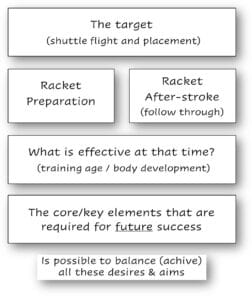Does the size of a badminton stroke matter?
Maybe it depends on ….
-
what the stroke is
-
the players’ physical capabilities
-
the context within the rally
How far should the racket move during the preparation and ‘after-stroke’?
That was the question someone asked
We were observing young players aged 8-11 who had been playing badminton for less than 12 months
They could make contact with the shuttle but displayed different racket movements before and after striking the shuttle. The movements certainly varied in size, and so did the power of the stroke!
The badminton stroke being practiced were the FH and BH from the midcourt
The coach demonstrate the ‘preferred’ (near perfect) technique and gave lots of great examples of what to do
We observed
- Players trying to copy the preferred technique but being unable to generate power
- Other players changed the technique, introducing a bigger backswing as part of the Preparation Phase, they wanted the power!
- Some players had even bigger preparations and follow-through racket movements
- The coaches had different reactions to these preparations and racket movements.
None of the young players could model the technique shown by the coach
All had bigger racket movements
The core of our discussion
- Is it ok to have larger racket movements if it achieves the aim at this younger age?
- Was it realistic to always expect shorter more powerful actions at all levels of play?
- Is there a different viewpoint concerning preparation and after stroke (follow through) – should we consider them separately?
- Does the context (rally situation) of the stroke need to be considered?
- Can we identify the core elements that need to be present, even if there are other variables in the current technique?
We found it difficult to agree on the points above
The coaching fights
Afterwards I reflected on what aspects were challenging us.
Would we ever find agreement, and if we did would be it set definitive statements (criteria) or a set of vague (all-encompassing) statements? All the different scenarios we observed and identified didn’t seem to help.
Backswing, follow-through, lack of power, too much power – we had so many things to discuss.
It was a fact that younger players couldn’t use techniques used by older players because of their lack of strength/coordination. What should coaches do in response to this?
How could we balance the aspect of giving the players a target, with their desire to achieve this by using large racket movements in preparation and follow-through.
Was it ok to ‘ignore’ the aspects we observed and believe that in time the technique would ‘sort itself out’.
If we didn’t try to resolve the ‘fights’, would we be giving the players the best start in badminton?
What happened next
We found it very difficult to agree on the way to determine the size/extent of the racket movement in preparation and aster-stroke (follow through)
Opinions ranged from …
“Short swings are best, even if it takes players a few years to master”
“It’s ok to have a larger preparation if the desire is power”
“Could we change our coaching approaches/desires depending on the players’ requirements at that time”
I’ll update you in a few weeks about our progress in trying to find agreement or at least common ground 🙂
– – – – – – – – – – – – – – – –

As always, I’m very grateful if you have read this far 🙂
Do you consider the size and extent of a badminton stroke, especially when working with new players?
Please let me know what you believe, expect and allow to happen – Does the size of a badminton stroke matter?
Why not send me an email contact@badmintonandy.com
This is part of a series of conversation starters.
Although not in detail, the posts are written to get you thinking and talking with others.







